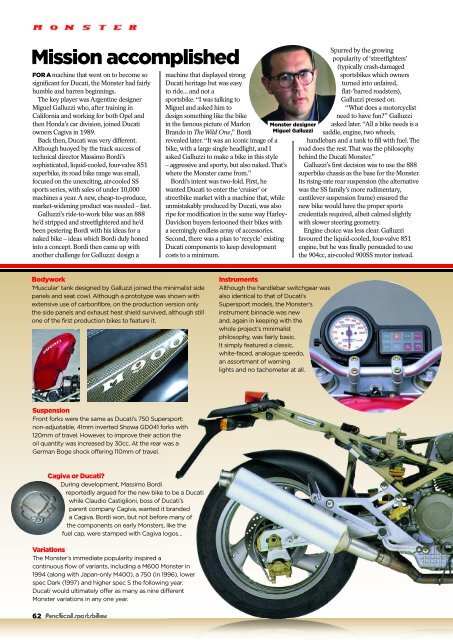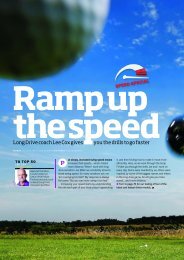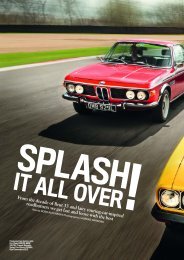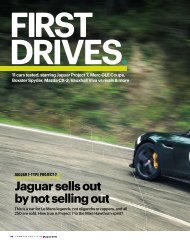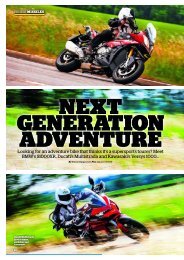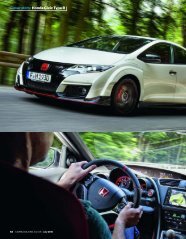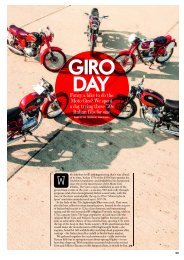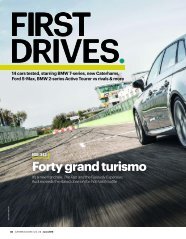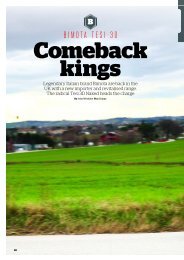Motorbikes.pdf
You also want an ePaper? Increase the reach of your titles
YUMPU automatically turns print PDFs into web optimized ePapers that Google loves.
Mission accomplished<br />
FOR A machine that went on to become so<br />
significant for Ducati, the Monster had fairly<br />
humble and barren beginnings.<br />
The key player was Argentine designer<br />
Miguel Galluzzi who, after training in<br />
California and working for both Opel and<br />
then Honda’s car division, joined Ducati<br />
owners Cagiva in 1989.<br />
Back then, Ducati was very different.<br />
Although buoyed by the track success of<br />
technical director Massimo Bordi’s<br />
sophisticated, liquid-cooled, four-valve 851<br />
superbike, its road bike range was small,<br />
focused on the unexciting, air-cooled SS<br />
sports series, with sales of under 10,000<br />
machines a year. A new, cheap-to-produce,<br />
market-widening product was needed – fast.<br />
Galluzzi’s ride-to-work bike was an 888<br />
he’d stripped and streetfightered and he’d<br />
been pestering Bordi with his ideas for a<br />
naked bike – ideas which Bordi duly honed<br />
into a concept. Bordi then came up with<br />
another challenge for Galluzzi: design a<br />
machine that displayed strong<br />
Ducati heritage but was easy<br />
to ride... and not a<br />
sportsbike. “I was talking to<br />
Miguel and asked him to<br />
design something like the bike<br />
in the famous picture of Marlon<br />
Brando in The Wild One,” Bordi<br />
revealed later. “It was an iconic image of a<br />
bike, with a large single headlight, and I<br />
asked Galluzzi to make a bike in this style<br />
– aggressive and sporty, but also naked. That’s<br />
where the Monster came from.”<br />
Bordi’s intent was two-fold. First, he<br />
wanted Ducati to enter the ‘cruiser’ or<br />
streetbike market with a machine that, while<br />
unmistakably produced by Ducati, was also<br />
ripe for modification in the same way Harley-<br />
Davidson buyers festooned their bikes with<br />
a seemingly endless array of accessories.<br />
Second, there was a plan to ‘recycle’ existing<br />
Ducati components to keep development<br />
costs to a minimum.<br />
Monster designer<br />
Miguel Galluzzi<br />
Spurred by the growing<br />
popularity of ‘streetfighters’<br />
(typically crash-damaged<br />
sportsbikes which owners<br />
turned into unfaired,<br />
flat-’barred roadsters),<br />
Galluzzi pressed on.<br />
“What does a motorcyclist<br />
need to have fun?” Galluzzi<br />
asked later. “All a bike needs is a<br />
saddle, engine, two wheels,<br />
handlebars and a tank to fill with fuel. The<br />
road does the rest. That was the philosophy<br />
behind the Ducati Monster.”<br />
Galluzzi’s first decision was to use the 888<br />
superbike chassis as the base for the Monster.<br />
Its rising-rate rear suspension (the alternative<br />
was the SS family’s more rudimentary,<br />
cantilever suspension frame) ensured the<br />
new bike would have the proper sports<br />
credentials required, albeit calmed slightly<br />
with slower steering geometry.<br />
Engine choice was less clear. Galluzzi<br />
favoured the liquid-cooled, four-valve 851<br />
engine, but he was finally persuaded to use<br />
the 904cc, air-cooled 900SS motor instead.<br />
Bodywork<br />
‘Muscular’ tank designed by Galluzzi joined the minimalist side<br />
panels and seat cowl. Although a prototype was shown with<br />
extensive use of carbonfibre, on the production version only<br />
the side panels and exhaust heat shield survived, although still<br />
one of the first production bikes to feature it.<br />
Instruments<br />
Although the handlebar switchgear was<br />
also identical to that of Ducati’s<br />
Supersport models, the Monster’s<br />
instrument binnacle was new<br />
and, again in keeping with the<br />
whole project’s minimalist<br />
philosophy, was fairly basic.<br />
It simply featured a classic,<br />
white-faced, analogue speedo,<br />
an assortment of warning<br />
lights and no tachometer at all.<br />
Suspension<br />
Front forks were the same as Ducati’s 750 Supersport:<br />
non-adjustable, 41mm inverted Showa GD041 forks with<br />
120mm of travel. However, to improve their action the<br />
oil quantity was increased by 30cc. At the rear was a<br />
German Boge shock offering 110mm of travel.<br />
Variations<br />
The Monster’s immediate popularity inspired a<br />
continuous flow of variants, including a M600 Monster in<br />
1994 (along with Japan-only M400), a 750 (in 1996), lower<br />
spec Dark (1997) and higher spec S the following year.<br />
Ducati would ultimately offer as many as nine different<br />
Monster variations in any one year.<br />
62<br />
Cagiva or Ducati?<br />
During development, Massimo Bordi<br />
reportedly argued for the new bike to be a Ducati<br />
while Claudio Castiglioni, boss of Ducati’s<br />
parent company Cagiva, wanted it branded<br />
a Cagiva. Bordi won, but not before many of<br />
the components on early Monsters, like the<br />
fuel cap, were stamped with Cagiva logos…


